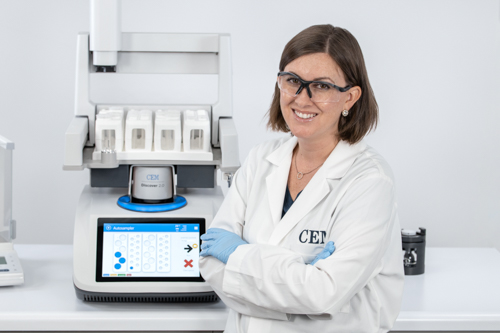Anwendungsbeispiele

Mikrowellenunterstützte Spezies-Analytik
Die folgenden Anwendungsbeispiele beschreiben den vorteilhaften Einsatz der Mikrowellentechnik bei der Spezies-Analytik.
Speziation

Anwendungsbeispiele
Die Autoren vom NIST in Gaithersburg, Maryland and NIST in Charleston, South Carolina, beschreiben den Einsatz des Mikrowellengerätes Explorer zur Extraktion der Hg Spezies mit TMAH und der anschliessenden Analyse von Methyl-Mercury in 2 Standard-Referenz-Materialien (Muscheln und Fischgewebe).
A new self-tuning single-mode-focused microwave technology has been evaluated in this work to perform the quantitative routine extraction of organometallic species from solid matrices of environmental interest. Species-specific isotope dilution analysis has been employed to better investigate the real influence of the microwave-assisted extractions on the final results. The advantages of such methodology in comparison with other established microwave units for the routine speciation analysis of organomercury and organotin compounds are discussed (such as the capability of using disposable glass vials, a self-tuning mode to provide an accurate control of the temperature and pressure inside of the vials, and the possibility of performing automated sequence of extractions with low sample size). The results obtained in this work demonstrated that such technology provides a fast and reliable quantitative extraction of the organometallic species in a wide range of extraction conditions even when the multi-elemental (Sn and Hg) species-specific determination is carried out.
After determination of total heavy metal concentrations in Tigris river sediments, a Tessier sequential extraction technique and a modified form using a microwave heating procedure were applied. Recoveries of total heavy metals from the sediment samples using the microwave and conventional techniques were reasonably comparable, in spite of a big difference in time required. 44–46% of Co, 24–36% of Cu, 69-81 % of Ni, and 55–73% of Zn were found in the residual fraction (i.e. not bioavailable).
Das Mikrowellensystem Discover erfüllt in vollem Umfang die Anforderungen der DIN EN 62321-7-7 (VDE 0042-1-7-2), Verfahren zur Bestimmung von bestimmten Substanzen in Produkten der Elektrotechnik, Teil 7-2: Bestimmung von sechswertigem Chrom (Cr(VI)) in Polymeren und Elektronik durch kolorimetrische Verfahren (IEC 111/212/CD:2011)
- Extraktion von Cr(VI) in löslichen Polymeren (ABS, HIPS, PC)
- Extraktion von Cr(VI) in löslichen Polymeren (PVC)
- Extraktion von Cr(VI) in löslichen Polymeren (PBT und PET)
- Extraktion von Cr(VI) in unlöslichen/unbekannten Polymeren und Elektronik
Die in dem Prüfverfahrenen beschriebenen Anforderungen an das Mikrowellengerät, die Qualität der Gefässe und die Rührung werden insbesondere im Discover voll erfüllt und sind in der Praxis einfach umzusetzten.
* Ich stimme zu, dass meine Angaben aus dem Kontaktformular zur Beantwortung meiner Anfrage erhoben und verarbeitet werden. Die Daten werden verschlüsselt übertragen und nicht an Dritte weitergegeben.
Hinweis: Sie können Ihre Einwilligung jederzeit für die Zukunft per E-Mail an info(at)cem.de widerrufen. Detaillierte Informationen zum Umgang mit Nutzerdaten finden Sie in unserer Datenschutzerklärung.
Die mit * angegebenen Felder sind Pflichtfelder.
Interessiert an weiteren Informationen?
Unsere Produktexperten stehen Ihnen gerne zur Verfügung. Kontaktieren Sie uns telefonisch oder per E-Mail – wir melden uns zeitnah bei Ihnen.